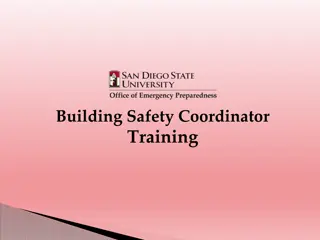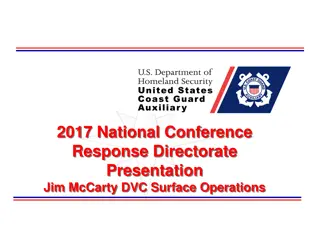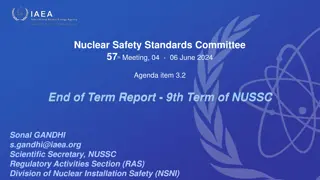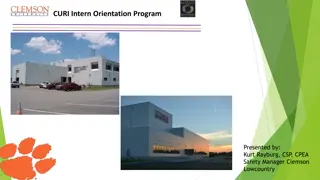Comprehensive Safety Orientation Program
This safety orientation program covers essential topics such as safety leadership, uncompromising safety practices, project-specific guidelines, grounds for removal from the project, safety policy, goals, and substance abuse policy. It emphasizes the importance of proactive safety measures, incident prevention, empowering all individuals to be safety leaders, and creating a safe working environment for employees, subcontractors, and the public.
Download Presentation

Please find below an Image/Link to download the presentation.
The content on the website is provided AS IS for your information and personal use only. It may not be sold, licensed, or shared on other websites without obtaining consent from the author. Download presentation by click this link. If you encounter any issues during the download, it is possible that the publisher has removed the file from their server.
E N D
Presentation Transcript
SAFETY ORIENTATION Instructor: Date: 1
SAFETY ORIENTATION Section 1: Safety Leadership 2
Uncompromising Safety Leaders Have courage Are comfortable being out in front while everyone else is behind them Take a stand when no one else will Get their energy from transforming and challenging the status quo 3
Uncompromising Safety Leaders Believe that all incidents are preventable Believe their commitment to safety is non-negotiable Believe everyone is empowered to be a safety leader Create the conditions for everyone to safely return home each night 4
Uncompromising Safety Leaders Are familiar with and follow all company and site safety rules Practice situational awareness If they see something at-risk, they address and/or report it immediately Contribute and participate in toolbox talks and other safety discussions 5
SAFETY ORIENTATION Section 2: Project-Specific Safety Guidelines 6
Grounds for Removal from the Project Failure to follow policies and procedures Failure to wear your PPE Fighting Alcohol or Drug Use or Possession Weapons Possession 7
Safety Policy and Goals All incidents are preventable. Everyone returns home without injury each day. Everyone is empowered to prevent incidents. Our goal is to create the conditions to ensure the safety of our employees, subcontractors, customers, and the general public. 8
Project-Issued Safety Fines and Violations Placeholder Insert your company-specific and/or project-specific safety fines and violations on this slide 9
Substance Abuse Policy We are committed to maintaining a safe and drug-free workplace We conduct post-incident, random and for cause testing. For more info, including our Employee Assistance Program (EAP), contact your HR rep More info can be found at http://www.drugfreeconstruction.org/ 10
Project-Specific Emergency Action Plan Insert project / company specific info here Exit Routes Muster Point Medical Information/ Local Hospital Insert exit route here Insert muster point here Insert medical info/local hospital info here 11
Cell Phone Policy Cell phone use is prohibited while: Conducting job responsibilities Operating company vehicles or machinery Standing within 10 feet of moving vehicles 12
SAFETY ORIENTATION Section 3: General Worksite Safety 13
Worksite Hazards OSHA s Fatal Four: Falls Electrocution Caught in/between objects (trench collapse, pinch points) Getting struck by an object (vehicles, falling objects) Do not enter restricted areas without permission Ensure work has stopped before entering an area. Do not work under suspended loads 14
Stop Work Authority Stop Work Authority empowers employees and contract workers with the ability and obligation to stop work if conditions are deemed at- risk If you see something that doesn t look right, say something to authorities or your supervisor 15
Pre-Job Planning Also known as: Job Safety Analysis (JSA) Activity Hazard Analysis (AHA) Pre-Task Plan (PTP) A step by step analysis of a specific activity, the potential hazards associated with the activity and the tools / methods necessary to mitigate those hazards Consider tasks that will be performed by other trades in proximity to your work 16
Globally Harmonized System (GHS) Ensures information about chemicals, including information and ingredients, can be universally communicated Formally known as the Hazard Communication Standard (HCS) or Haz- Com 17
Safety Data Sheets (SDS) Provides all information necessary to safely handle a particular chemical Must be readily accessible to any employee using a hazardous chemical Any chemical identified with a label that states Danger, Caution, or Warning must have a SDS 18
Safety Data Sheets (SDS) Most useful sections to know: Section 1: Identification Chemical name, emergency contact info, recommended use, etc. Section 2: Hazard(s) Identification All hazards regarding the chemical; required label elements Section 4: First Aid Measures Important symptoms/effects, acute, delayed; required treatment Section 5: Fire-Fighting Measures Suitable extinguishing techniques, equipment, chemical hazards from fire 19
Safety Data Sheets (SDS) Section 6: Accidental Release Measures Emergency procedures; protective equipment; proper methods of containment and cleanup Section 7:Handling and Storage Precautions for safe handling and storage, including incompatibilities Section 8: Exposure Controls/Personal Protection OSHA s Permissible Exposure Limits (PELs), ACGIH Threshold Limit Values (TLVs), and any other exposure limit used or recommended by the chemical manufacturer along with personal protective equipment (PPE) requirements 20
Housekeeping Keep your work area clean at all times Place cords and hoses overhead to prevent tripping hazards Dispose of trash in the proper containers Bend or back out nails in scrap lumber 21
SAFETY ORIENTATION Section 4: Occupational Health and Wellness 22
Silica Employers must replace crystalline silica materials with safer substitutes whenever possible When feasible, employers must use engineering or administrative controls such as local exhaust ventilation and blasting cabinets to reduce exposures below the PEL Use protective equipment or other protective measures if engineering controls are not adequate Use all available work practices to control dust exposures, such as water sprays and integrated water delivery systems 23
Silica Participate in training, exposure monitoring, health screening, and surveillance programs to monitor any adverse health effects caused by crystalline silica exposures Be aware of the operations and job tasks that create crystalline silica exposures in your workplace environment and know how to protect yourself Be aware of the health hazards related to exposures to crystalline silica Be aware that smoking adds to the lung damage caused by silica exposures 24
Silica Do not eat, drink, smoke, or apply cosmetics in areas where crystalline silica dust is present Wash your hands and face outside of dusty areas before performing any of these activities Wear only a N95 NIOSH certified respirator if respirator protection is required Do not alter the respirator Do not wear a tight-fitting respirator with a beard or mustache that prevents a good seal between the respirator and the face Wear disposable or washable work clothes and shower if facilities are available Vacuum the dust from your clothes or change into clean clothing before leaving the work site 25
Blood Borne Pathogens If it is reasonably anticipated employees will be exposed to blood or other potentially infectious materials while using first-aid supplies, employers should provide personal protective equipment (PPE) including, but not limited to: Gloves Gowns Face shields Masks Eye protection 26
Injury Reporting Report all work related injuries to your supervisor immediately Injury types include, but are not limited to: Minor cuts Scrapes Scratches Burns Other treatments that require minimal training or technology to administer Know the location of first aid supplies 27
SAFETY ORIENTATION Section 5: Personal Protective Equipment 28
Head Protection Wear hard hats where there is a potential for: Objects falling from above Bumps to the head from fixed objects Accidental head contact with electrical hazards Routinely inspect hard hats for: Dents Cracks Deterioration Replace after a heavy blow or electrical shock Maintain in good condition 29
Eye Protection Must be worn onsite at all times Prescription glasses, with side shields, must meet minimum ANSI requirements 30
Hearing Protection OSHA recommends that workplace noise levels be kept below 90 dBA as an 8-hour time-weighted average As the noise level increases, it damages your hearing more quickly If a sound level meter is not available use the 2-to-3 foot rule: Stand about an arm s length away from your coworker If you have to raise your voice to be heard 2-3 feet away, assume the sound level is at or above 90 dBA 31
Foot Protection Composite toe footwear is recommended A minimum 6 boot is highly recommended 32
Hand Protection Insert your company hand protection policy here 33
Respiratory Protection Employers must develop and implement a written respiratory protection program with required work specific procedures Employers must use NIOSH-certified respirators Employees must be medically approved and trained before they are assigned a task requiring respirator use Employees must be fit tested if using a negative or positive pressure tight-fitting facepiece 34
High Visibility Clothing At a minimum, a class II reflective vest should be worn while working onsite High visibility clothing may be worn in lieu of the vest 35
SAFETY ORIENTATION Section 6: Fall Protection/ Working at Heights 36
Fall Protection Falls are the #1 cause of injury and death on construction sites All employees exposed to a fall > 6 , must be effectively tied off That means the fall distance and anchor point have been calculated / approved by a competent person and is deemed adequate Harness and lanyards must be inspected daily Remove from service if defects are found 37
Aerial Lifts Articulating boom lifts Must be tied off while inside the basket, even if boom is not extended Must be trained on the specific model that you are operating Operators must remain in the lift basket at all times (feet on the floor, not railing) Scissor lifts Follow manufacturer's, site guidelines for fall protection Must be trained on the specific model that you are operating Overhead work warnings (signs, barricades), should be in position 38
Guardrail Systems Typically are 42 in height (+-3 ) with a midrail installed at least 21 in height Must be able to withstand 200 lbs. of force, in any direction, without failure Top rail deflection must not exceed 3 Wire rope must be at least in diameter and flagged every 6 for visibility 39
Personal Fall Arrest Systems (PFAS) PFAS must be inspected prior to each use for wear, damage, and other deterioration Defective equipment must not be worn and must be immediately removed from service Lanyards must be shock absorbing and must be attached to the Dee- ring in the middle of the back at the shoulder level Anchor points must be able to withstand at least 5,000 lbs. Think the weight of a pickup truck 40
Personal Fall Arrest Systems (PFAS) The employer must provide for prompt rescue of employees in the event of a fall PFAS cannot be attached to guardrail systems Positioning devices must be rigged so that the employee cannot fall more than 2 Positioning devices must be connected to an anchor capable of supporting at least twice the load impact or 3,000 lbs., whichever is greater 41
SAFETY ORIENTATION Section 7: Fire Safety 42
Fire Protection Fire extinguishers must be conspicuously located and periodically inspected Travel distance to an extinguisher must not exceed 100 In a multistory building, extinguishers must be located at each stairwell on every level A fire extinguisher must be within 50 of any outdoor storage of flammable liquids exceeding 5 gallons 43
Flammable Liquids Flammable liquids must be stored in metal safety cans containing a spring loaded top and a flash arrestor Flammable liquids must not be stored near stairwells or other access / egress points Flammable liquids may not be stored in plastic containers No more than 25 gallons of flammable liquids may be stored in a room outside of an approved storage cabinet Outdoor storage must not exceed 1,100 gallons, in any one area, and be positioned at least 20 from any building 44
Liquefied Petroleum (LP-Gas) LP-Gas containers must not be stored within buildings, regardless of whether they are full or empty When stored outdoors, containers must be in a suitable, well ventilated enclosure At least one 20-BC fire extinguisher must be in place Outdoor storage distance from buildings is as follows: < 500 lbs 0 501-6,000 lbs 10 6,001-10,000 lbs 20 > 10,000 lbs 25 45
SAFETY ORIENTATION Section 8: Equipment and Tools 46
Heavy Equipment Do not operate vehicles in reverse with an obstructed rear view unless it has a reverse signal alarm capable of being heard above ambient noise levels or a signal observer indicates that it is safe to move Be aware of blind spots Make eye contact with the operator when entering their work area Only use equipment for its intended purpose Maintain a minimum 10 safe working distance from electric lines 47
Ladders and Stairways A ladder or stair must be provided at all work points of access where the break in elevation is > 19 and no ramp, runway, sloped embankment, or personnel hoist is provided A double cleated ladder or two or more separate ladders must be in position when there are 25 or more employees in an elevated work area 48
Ladders Maintain a 3-point contact Two hands and a foot, or two feet and a hand when climbing/ descending a ladder Stay near the middle of the ladder and face the ladder while climbing up or down Only put ladders on a stable and level surface that is not slippery Extend the top of the ladder three feet above the landing 49
Ladders Stepladders must be opened fully and locked while in use They cannot be used as straight ladders Ladders must be secured to prevent accidental displacement Ladders must be used as designed Not as scaffold planks, bridges , etc. Set the ladder at the proper angle When a ladder is leaned against a wall, the bottom of the ladder should be one-quarter of the ladder s working length away from the wall 50























